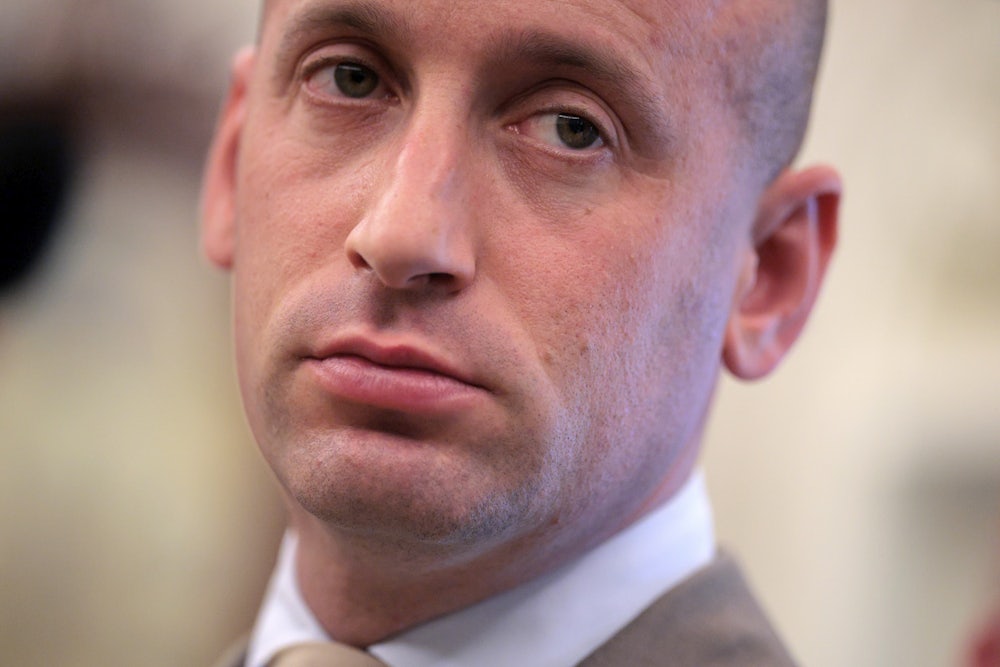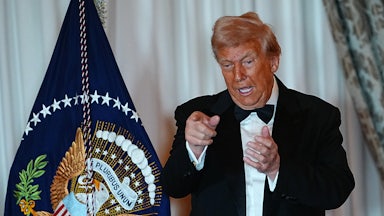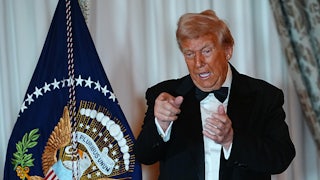Stephen Miller has a theory about this political moment. As President Trump expands his lawbreaking and dictatorial rule, the powerful MAGA disinformation apparatus—at Miller’s direction—is supercharging public attention to the debate over Trump’s conduct in a way that’s designed to deeply polarize it. That will force Americans to take a side in that standoff, Miller clearly believes, driving them to embrace authoritarian rule, though perhaps without understanding it in exactly those terms.
Do Democratic leaders broadly have their own theory about this moment? It’s unclear. But here’s what we can divine right now: Governors JB Pritzker of Illinois and Gavin Newsom of California do have one. They grasp Miller’s theory of the case, and they are responding in kind, with their own war for attention, on the intuition that voters will side with the rule of law over authoritarian dictatorship—if they are presented with this as a clear choice.
This week, Trump threatened to invoke the Insurrection Act after a federal judge blocked him from sending the National Guard into Portland, in a ruling that sharply noted Trump is making up facts about crime there as his pretext.
“It’s a burning hellhole,” Trump said. “You have a judge that tries to pretend there’s no problem.” Trump declared that he’d enact the Insurrection Act “if people were being killed and courts were holding us up, or governors or mayors were holding us up.”
The specter of Portland “burning” is dim-witted MAGA propaganda. But Trump is now nakedly threatening to invoke the notorious nineteenth-century act if Democratic governors or the courts lawfully exercise their roles in our constitutional schema, in a way that displeases him. This would unshackle vast and dangerously vague authorities to domestically deploy the military, powers nominally reserved for extraordinary domestic unrest or civil breakdown. Trump would invoke it based on sheer fabrications, or possibly on old footage of Portland he saw on Fox News.
Yet it’s no accident that this comes right after Miller loudly denounced the Portland ruling by that judge—a Trump appointee, no less—as “legal insurrection.” Miller declared that it’s “insurrection” when judges assume for themselves “powers that have been delegated by the Constitution to the president.” Miller is also insisting that judges “have no conceivable authority” to restrict the commander in chief from “dispatching members of the U.S. military to defend federal lives and property,” meaning in Portland.
Of course, here in non-MAGA reality, the judge was merely interpreting whether Trump breached the limits Congress has already placed on that presidential authority. She concluded that Trump doesn’t have unlimited power to simply declare that the conditions permitting him to federalize a state’s National Guard have been met. In other words, as Harry Litman argued at TNR, facts matter. But that’s precisely what Miller denies. His argument, in essence, is that Trump’s power to declare by fiat that those conditions have been met really is quasi-absolute.
To that end, Miller appears to want Trump to invoke the Insurrection Act. Recently, Miller was asked directly if he’s discussed the idea with Trump, and he evaded the question. It’s likely that Miller, a master manipulator lurking furtively behind the despot’s throne, frequently uses the word “insurrection” about Trump’s opponents to lodge it deep in Trump’s brain stem and make invocation of the act more likely. As The Bulwark’s Andrew Egger notes, Miller’s goal is to supplant the rule of law with the “rule of Trump,” a personalist form of rule that answers to Trump the man and no one else.
Yet there’s another dark aim here that’s worth appreciating. Miller is working overtime to polarize the public debate about Trump’s increasingly dictatorial abuses of power. And he’s doing so quite consciously. He relentlessly depicts Democrats as allied with a vast, inchoate class of violent criminals and insurrectionists operating in every shadow of American life. Miller seizes on every attention-grabbing moment he can to amplify the point, even if—and this part is crucial—it looks likely at first to reflect negatively on Trump.
Consider what happened after ICE raided an apartment building in Chicago last week. As Garrett Graff chronicles, media coverage was brutal: It depicted jackbooted federal agents busting down doors and dragging children, some naked, out into the dark streets.
Yet MAGA was undaunted. State-sponsored propaganda video depicted the affair as akin to an action movie featuring the thrilling spectacle of defeated-looking migrants in handcuffs. Miller went on Fox News to hail the operation as an enormous triumph.
Amid all this, Miller’s public battle with Illinois Governor JB Pritzker has been particularly noteworthy. Pritzker went on CNN and tore into the ICE raid, vividly depicting it as a lawless action targeting U.S. citizens in order to provoke a response and justify more thuggery later. Pritzker called it “Trump’s invasion,” deliberately using a term Miller uses for immigrants. Miller eagerly took the bait:
.@StephenM says the ICE raid targeting Tren de Aragua terrorists in Chicago "was one of the most successful law enforcement operations the we've seen in this country."
— Rapid Response 47 (@RapidResponse47) October 6, 2025
"These ICE officers—these heroes—saved God knows how many lives by getting these TdA SCUM out of our country." pic.twitter.com/wRNHfUDgvT
The rub here is that both these men want this fight. To be clear, the public is squarely with Pritzker: A new CBS survey finds that 58 percent of Americans oppose Trump’s National Guard deployments. And G. Elliott Morris’s recent poll finds opposition to National Guards assisting ICE at 51 percent to 37 percent.
But in Miller’s worldview, polls like that only register shallowly held convictions, at best. In this understanding of politics—and you should read Brian Beutler and Lee Drutman on this—what really matters is the political attention economy, and how conflict plays within it. Supercharging searing civil tensions over jarring high-profile events drives attention, jolts low-propensity voters out of their information ruts, and compels them to really take sides.
Pritzker and Newsom are now plainly motivated by an understanding like this one. Pritzker has plunged very deeply into the public argument over Trump’s troops in Chicago. In urgent moral language, he has told his state’s residents that Trump represents a dangerous threat to their way of life. Newsom has done the same. After Trump tried to dispatch California’s National Guard into Portland, Newsom warned: “America is on the brink of martial law.”
In short, Pritzker and Newsom see it as a defining challenge of this moment that Trump is consolidating authoritarian power daily, and using it to subjugate and dominate blue America as if it’s akin to an enemy nation within. And they are shaping their approach accordingly.
Miller plainly believes there’s a latent majority out in the country that can be sleepwalked into authoritarianism. If Democrats sit this debate out, Miller has calculated, Trump’s deceptions can flood public information spaces, persuading low-info, low-attention voters that his autocratic encroachments constitute a proportional response to the civic unrest he keeps propagandizing about.
What’s notable, in one sense, is how badly this project has failed. Despite months of effort, Trump and Miller have not come close to manufacturing the sense of fear or trauma out in the country they’d hoped for. But in the nascent Pritzker-Newsom understanding, assuming this will all take care of itself—that voters will resist Trump-Miller agitprop without prompting—is insufficient. We’ve learned, hearteningly, that majorities seem to harbor a deep attachment to liberal rights and liberties, one that instinctively recoils at masked kidnappings, at hypermilitarized vehicles on urban boulevards, at the trappings of totalitarian dictatorship. But this must be activated. That takes conflict and controversy—powerful imagery and language that rivets attention.
It’s not clear many Democrats understand this. Some Democrats have confided to reporters that they see this topic as a “trap” enticing them into a losing debate about crime. But why assume voters will automatically believe Trump’s occupations are actually about combating crime? This throws in the towel, right up front, on communicating to voters what this debate is really about: that Trump’s abuses should be utterly abhorrent to anyone who values living in a free society.
Do Democrats, broadly speaking, have a theory of this moment that’s consciously matched to MAGA’s authoritarian politics? They need one. Because guess who does have a theory of the moment? Miller does. And he’s amassing unprecedented power to put it into practice as we speak.






